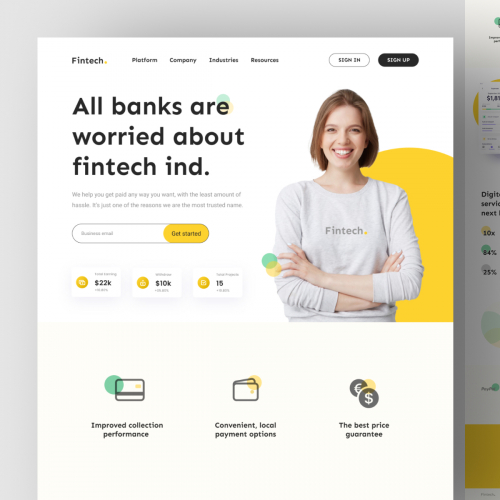How Website Design Can Help Improve User Experience and Engagement
How Website Design Can Help Improve User Experience and Engagement
Blog Article
The Ultimate Guide to Modern Web Site Style Trends
In the ever-evolving digital landscape, modern-day internet site design fads play a vital function in shaping user experience and involvement. From the rise of minimalist design concepts that prioritize simplicity to the impact of bold typography in defining brand identification, each component contributes to a cohesive on the internet existence.
Minimalist Style Principles
Minimal design principles stress the concept that less is extra, promoting for simpleness and functionality in aesthetic communication. This method strips away unnecessary elements, concentrating rather on essential elements that share the intended message properly. By focusing on clarity, minimalist design improves customer experience, enabling visitors to browse internet sites effortlessly.
Core tenets of minimal style consist of using adequate white area, which creates a sense of equilibrium and organization. This unfavorable space not just directs the viewer's interest to essential aspects yet additionally promotes a calming visual environment. Furthermore, a minimal color scheme is typically utilized, making use of soft colors or single plans to maintain visual cohesion and protect against frustrating the user.
Typography plays an important function in minimal style, where readable typefaces are selected for their simpleness and performance in communicating material. Graphics and photos are made use of moderately, making sure that they offer a function rather than sidetrack from the total message. Ultimately, minimalist style principles cultivate a concentrated environment that motivates customers to involve with the web content, boosting the general effectiveness of modern-day web site layout. This trend reflects a growing admiration for thoughtful, user-centric appearances in electronic spaces.
Bold Typography Choices
Accepting strong typography selections has ended up being a defining attribute of modern web site style, as it effectively catches interest and communicates strong messaging. Designers are progressively utilizing typography not simply as a functional component but as an essential aesthetic element that boosts the general aesthetic and customer experience.

Moreover, the association of strong typography with minimalist layout concepts permits striking contrasts, boosting readability while preserving aesthetic allure. Using whitespace around vibrant text even more highlights its significance, guaranteeing that the message reverberates with the target market.
As digital landscapes end up being much more affordable, leveraging strong typography enables brand names to separate themselves and leave an enduring perception. The cautious option of font styles and their application can stimulate emotions, establish tone, and drive activity, making vibrant typography a crucial device in modern-day internet site design. Eventually, it is an effective means to improve narration and make certain that key messages are not only seen yet likewise felt.
Responsive and Mobile-first Style
Mobile-first and receptive design has actually arised as a crucial concept in contemporary site development, reflecting the boosting reliance on smart phones for accessing on the internet company website content. As individual actions shifts in the direction of mobile surfing, developers must focus on creating experiences that adjust perfectly across various display sizes and resolutions.
A responsive style makes sure that a website automatically adjusts its layout, images, and functionality based on the gadget being utilized. This strategy enhances customer experience by providing consistent navigation and readability, irrespective of whether the visitor is on a tablet, desktop computer, or smartphone computer system. In addition, mobile-first style supporters for developing websites initially for smaller sized displays, consequently scaling up to larger displays. This method encourages an extra efficient and structured layout procedure, concentrating on vital content and capability first.
Implementing responsive and mobile-first principles not just satisfies user choices however additionally straightens with search engine optimization (SEO) practices. Significant online search engine, like Google, focus on mobile-friendly websites in their rankings, making it crucial for businesses to adopt these design approaches. In an affordable digital landscape, welcoming receptive and mobile-first style is not just a choice; it is important for making sure availability and involvement with a diverse target market.
Involving Microinteractions
Microinteractions play an essential duty in improving user engagement and total site experience, particularly in the context of responsive and mobile-first style. These refined layout aspects give prompt comments to individuals, making communications much more delightful go to the website and instinctive. Instances include button animations, notification signals, and loading signs, which not just overview individuals but likewise develop a sense of link with the user interface.
Including engaging microinteractions can substantially improve use by minimizing cognitive load. When users obtain acoustic or aesthetic feedback upon executing actions, such as clicking a button or submitting a kind, they really feel more positive in their options. This fosters a smoother navigation experience, ultimately increasing customer retention.

As internet site design trends proceed to progress, the significance of microinteractions can not be overemphasized. They work as the refined yet effective touchpoints that transform common interactions right into phenomenal experiences, therefore boosting the total effectiveness of modern-day website design.
Lasting Website Design Practices
Lasting internet layout methods are ending up being increasingly essential as the digital landscape expands and environmental concerns increase. Developers and developers are recognizing their obligation to create sites that not only serve user needs yet also minimize ecological impact. This technique incorporates numerous crucial approaches.
Firstly, maximizing energy usage is vital. Websites need to be additional hints designed to load promptly and successfully, which reduces server power use and boosts user experience. Techniques such as picture compression, reducing HTTP requests, and utilizing modern coding techniques add significantly to this goal.
Secondly, choosing green holding providers is critical - website design. Several holding companies are now powered by eco-friendly power sources, making it possible for web sites to run in a much more sustainable fashion. This choice shows a dedication to reducing carbon impacts
Additionally, adopting a minimalist style can boost sustainability. Fewer aspects on a page result in less data transfer, which not just quickens filling times yet likewise saves resources.
Lastly, promoting digital ease of access ensures that internet sites get to a larger target market without unnecessary bloat, aligning customer experience with environmental obligation. By integrating these sustainable methods, web developers can add positively to both customer involvement and the planet's well-being.
Conclusion
In summary, modern web site style patterns highlight the integration of minimalist concepts, strong typography, and responsive style to boost customer experience. Embracing these fads is important for creating impactful digital experiences that reverberate with individuals in a progressively competitive online landscape.
In the ever-evolving electronic landscape, modern website style fads play a vital role in forming user experience and engagement. By prioritizing clearness, minimalist design improves user experience, permitting visitors to navigate websites easily.
Eventually, minimal style concepts cultivate a concentrated atmosphere that motivates customers to involve with the material, improving the general effectiveness of contemporary internet site design.Microinteractions play a pivotal role in improving user involvement and general web site experience, particularly in the context of mobile-first and responsive design.In summary, contemporary internet site style fads emphasize the combination of minimal principles, vibrant typography, and receptive design to boost individual experience.
Report this page